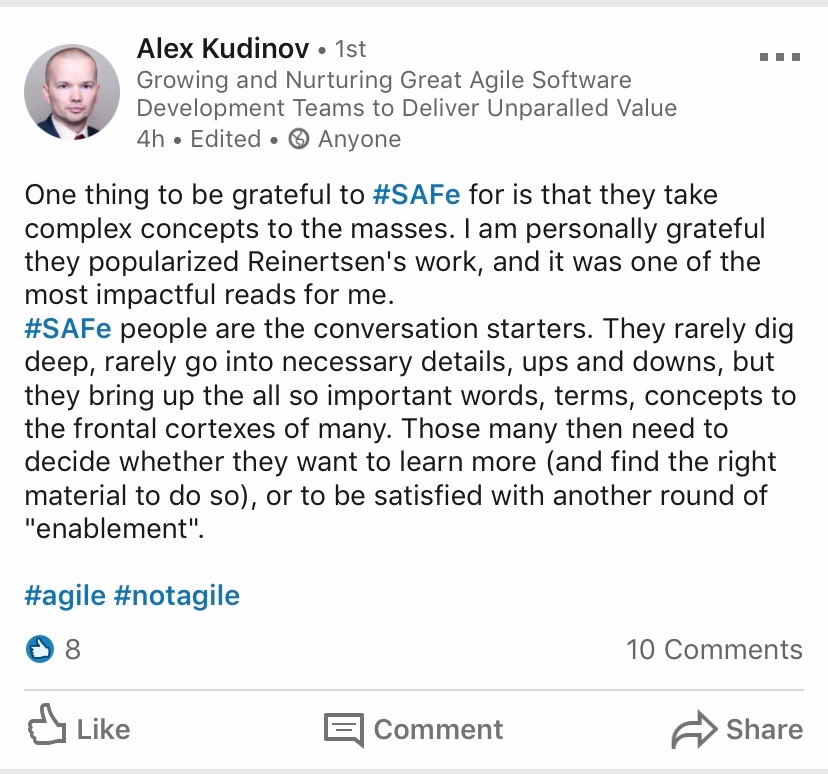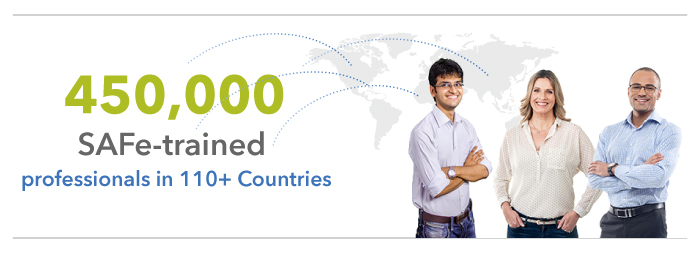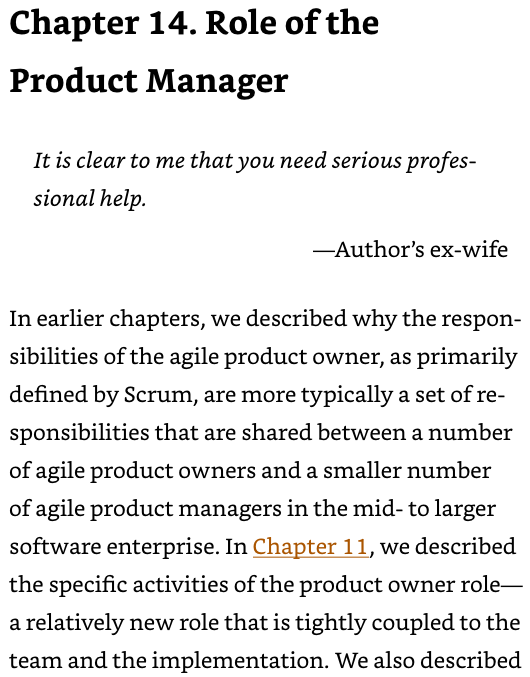
September 2019 trolls update
It seems that hate and jealously knows no bounds with some people. They simply cannot practice what they preach and be respectful, therefore diminishing any rational argument they would make. Here are a few new in the cast of characters that troll the SAFe with misrepresentations and outright hateful comments.


https://www.linkedin.com/feed/update/urn:li:activity:6585263102634311680?commentUrn=urn%3Ali%3Acomment%3A%28activity%3A6585263102634311680%2C6585372081599377408%29
The problem with trolls
I updated the title of the article. I have observed a pattern over the past year or so of Scrum Alliance aligned folks like Certified Scrum Trainers (CST) and other certified Scrum folks writing articles and posts of varying degrees of criticism from valid debates over ideas (rare) to mostly disparaging misrepresentations, to openly hostile, to outright extremist comments like the picture above. I changed the article title to properly address not all CST’s. The original title was meant to address the pattern observed by many people in the industry of several unnamed CST’s making hateful comments about SAFe and the people behind the SAFe.
Remember, hate comes in many forms. All of it is bad, and unacceptable. I’ve lost count of the number of people that I have known, loved, and like that have died or suffered from cancer (and parasites). Attributing those words to the good people behind the SAFe is absolutely abhorrent, evil behavior. The picture above is just the latest attack. So, I apologize for the original generalization.
There are also two parts to this article. The first part addresses the hateful opening comment from Alexey. The second challenges the misrepresentations of the SAFe. These are separate discussions. Debating ideas is necessary. We should not ever accept hateful words or behavior.
Why bother?
Let me start by explaining why I even bother debating with hateful people in the first place. Because we must confront evil in the world. Yes, at its root this is evil, misguided behavior. If we want to move ideas forward to innovation they must be challenged in a respectful, professional manner.
Anyone that starts out a conversation by saying you or your thing is a “cancer and parasite” isn’t actually looking for conversation. They are being hateful and are probably ignorant on the topic of debate. If this were a political topic then perhaps the bad behavior could be expected because it has been normalized for millennia. Does it make it right? Emphatically, no.
I find it disturbing that extremists and their ilk who are supposedly exemplars for the Agile Manifesto and values of Scrum openly display behavior that is antithetical to the Agile Manifesto and Scrum. After all, “RESPECT” is a value of Scrum. And the manifesto has a clear purpose, “We are uncovering better ways of developing software by doing it and helping others do it.“
Are extremists “helping others do it” by labeling them a cancer and parasite?
I also want to point out that it is a logical fallacy to make the assertion that one can criticize only a thing and not the people that created the thing. People create things in this reality by changing what we perceive as the world, they don’t randomly spawn. The creation is inseparable from the creator.


For example, let’s say that a fictional professional football coach made the following statement, “The Chicago Bears are a cancer and parasite on the heart and soul of football,” or akin to saying, “Volkswagen is a cancer and parasite on the heart and soul of the automobile world.”
SAFe is a cancer and parasite (choose any metaphor) on the heart and soul of Agile.
– A. Krivitsky
Obviously, this is a derogatory statement that attacks the people behind the tool, the framework, and does not challenge the ideas. These kinds of statements reek of a hateful vitriol. Even for people who are not aware of the “Agile” -sphere would consider this type of language incendiary and unnecessary as a conversation starter.
In the real world, businesses that are successful never use this kind of language to denigrate their competition. If they do so, it is at their own peril, because it shows a lack of discipline, respect, and also self-exposes the weakness of a bad player in the market.
So this leaves open the question, “Why are Scrum Alliance aligned folks in particular so openly hostile and hateful towards the SAFe?” The industry at large clearly posits the SAFe as a market leader in the “scaling agile” space. And it is equally as obvious that the Scrum Alliance, whom the subject CST aligns himself with, have been building competing scaling frameworks with the SAFe. All of the various formal flavors of Scrum Alliance favored or sponsored scaling frameworks have failed to gain any significant market share over the past five years, as evidenced by the last five VersionOne State of Agile surveys and reports. One need only look at training metrics to see another facet of the downward trends for Scrum Alliance vs. SAFe courses.
Someone challenged my assertion above. Here is the evidence. Scrum Alliance had a 10 year head start on Scaled Agile. In 2019, Scaled Agile and her partners have trained over 450,000 professionals vs. 750,000 for the Scrum Alliance in 18 years. The numbers speak for themselves. Scaled Agile will likely surpass Scrum Alliance numbers in the next two years. The fact is that the growth rate of SAFe is several orders of magnitude greater than the Scrum Alliance marketed solution. May the best ideas win.
Founded in 2001, we’re the largest, most established and influential professional membership and certification organization in the Agile community. Our nonprofit association has certified more than 750,000 practitioners worldwide.
Scrum Alliance

The Chef
Criticizing a tool with extreme comments and misrepresentations is akin to blaming the chef for a waiter that fails to deliver the food before it gets cold. Is it really the fault of the food and the chef? Or perhaps it has something to do with the last leg of delivery?
Part 2 – Breakdown and responses
—- longer read: I don’t think that SAFe is a healthy method.
Well, this should have been Alexey’s opener. It invokes a thought in a respectful way, yet clearly demonstrates that the author has some further insight into why the SAFe isn’t healthy. It could have been written even more eloquently. Perhaps, “I would like to explore my thoughts with the community on why it is difficult to achieve organizational agility with SAFe using common agility health survey tools.”
I’ve talked to different people and diff organizations implementing it. And most people hate it.
Krivitsky
And most people hate it. Really? Most people believe that Bud Light is beer. That doesn’t make that opinion valid. How many people and organizations did Alexey speak with? two? five? twenty five? What is the basis of evidence to support this statement? This is an invalidated opinion of one person not a scientific study and not even a proper market study. I would point out that one of the very few proper market studies shows the SAFe as the market leader, with 30% of the share in scaling agile. Who should we believe? The spurned Scrum Alliance aligned extremists, competitor to the SAFe, or an independent market research survey?
Furthermore, there is no other information provided to support the statement. Why did most people and organizations hate it? I have experienced, in my pre-SAFe years, many organizations and people, particularly engineers and developers, that said, “I hate Scrum and Agile…” We change agents move peoples cheese, and then they have emotions. It’s almost uncanny how this happens! I mean, c’mon people, what’s up with the emotional responses to change? You all should totally stop being human! [sarcasm alert]
Now, have you seen me on LinkedIn and the Book of Face leading a crusade against the cancer and parasites known as Scrum and Agile? No, you haven’t. Because free thinkers understand the value and purpose of these tools and how and when to apply them in organizations to influence organizational change.
SAFe is maybe a not a bad idea for companies that are in a total disastrous state. But why to safe dinosaurs? Maybe we shall let them extinct?
Ohh. A crack in the armor. I could swear Alexey just threw the SAFe a bone! But, but, I’m confused because he said SAFe was a cancer and parasite. So, what exactly is he saying? If an organization is going through a burning platform era the SAFe is “maybe not a bad idea” as a solution to help grow and innovate out of that state?

Why yes, Alexey, I couldn’t agree more. Burning platforms are great motivators for a guiding coalition. Great consultants and coaches know how to inspect and adapt an appropriate plan of action and tooling to help organizations grow and innovate. Great consultants and coaches also have awareness of and know that cognitive bias’s are dangerous, risky, and often lead to logical fallacies, and fear — of failure? And even Yoda knows that fear leads to suffering and suffering leads to death of Agile. Or perhaps it never lived?
So, a great consultant and coach is going to choose tools wisely, and the plan and tools will adapt to the needs of the customer.
Psychological awareness side note for the community at large.
This can be done easily when combined with hard work, servant leadership, and with the SAFe, and/or other tools, knowledge, and frameworks. We must always remember that the goal IS NOT THE TOOL OR FRAMEWORK. The goal should be selfless and an arbiter of goodwill for an organization, a move towards truth and innovation through organizational change.
I don’t appreciate the complexity SAFe is adding and the approach of managing existing complexity. Extra roles, extra ceremonies, extra hierarchies? Is that helping organizations to become more adaptive?
Krivitsky
Now we are getting somewhere. Almost somewhere. There is a big assumption laying there in the first sentence, “complexity SAFe.” First, the assumption is that you cannot manage complexity with a complex tool. This logic is obviously validated in the fields of artificial intelligence, string theory, and brain surgery. Obviously, not?
Complexity is perception. Perceptions are influenced by what can be sensed and probed, consumed, and understood. Perceptions can be changed. How do we change perceptions? Through discourse, knowledge transfer, collaboration, communication, and through leadership.
To the uninitiated, which is more complex?


So, are we talking degrees here? If so, that is simply a market differentiator. A function of quality of product? Simple is good. The AM even says it’s essential. But, then systems thinking bears out. And then organizations realize they need more than just Scrum master and Product Cycles. Oops. More tooling necessary. More complicated, more complexity. Build it? Buy it? Analysis paralysis. Nothing changes. Revert to form. The new CxO just killed our Scrum transformation. Oh well darn, we should have used Systems and Lean thinking.
And then there are other important questions. Is the SAFe solving a problem that Scrum@scale does not? Or, perhaps Scrum@scale does not acknowledge the two systems problem? Lean budgets? Lean Portfolio Management? Governance?

One could argue that the first solution does not in fact utilize the concepts of systems thinking. The latter does, as the SAFe approaches change and guidance for 1.) the enterprise and 2.) the product and flow. Scrum @scale ignores the enterprise. At least to the uninitiated?
So, the SAFe includes guidance on how to start an approach to systems thinking for the enterprise and product development. That sounds like comprehensive guidance, not complexity.
The result? Less work needed for the enterprise to figure out or invent ways to build connections, a networked enterprise, that spans the full decision making gamut, so that organizations have a chance to realize business agility at scale. Not just with teams doing the work, but as one cohesive unit — one team of teams dynamically moving the ball down the field to achieve objectives and transport value.
Interestingly, I asked my wife to look at the picture of Scrum@scale and the SAFe Big Picture for a few minutes and then tell me which one was more complex. She knows I’m a management consultant, but has no knowledge of the field. She is a personal trainer and RN by trade. She said, “the first one is simpler, but the second looks like it has more answers. But I don’t understand either one.”

Also I don’t like the way SAFe treats Scrum making it a team-level method. Scrum can be applied to the product level. And this has always been its scope. Talk to Ken. This also downgrades ScrumMasters from change champions down to pawn in the game “enterprise agile adoption”.
Krivitsky and Kenny
I’ll just answer this one directly, and simply. The SAFe uses Scrum in all configurations and at scale at all layers. Yes, Scrum at the portfolio layer. Where appropriate? Let the teams receive the knowledge, then decide. We call it self-organization. Self-Management even, what a lofty goal? Not for servant leaders.
PDCA is explicitly called out in the framework materials at all levels (and OODA to a degree). Any good SPC knows that what’s good for the team building the product is good for the team making less frequent decisions. In any CAS, we set the stage for relentless improvement. Let the people probe and sense and decide and act. The SAFe core values, the House of Lean, and the nine principles support exactly this paradigm.
A SAFe implementation is meant to be visually and structurally (say in your mind) flat, as layers of concentric circles, a de-scaling of hierarchy. It’s hard to draw a complete picture like that in two dimensions. Hence the Big Picture. If you know the company Scaled Agile, you would know that they exemplify this model well.
I don’t like how SAFe puts product owners into hierarchies and small boxes. This creates an inevitable ground for local optimization and politics. One “product CEO” is what most companies need and this is what Scrum promotes. That is Scrum 101. (Some ideas SAFe borrowed from Lean are of course healthy.)
Krivitsky


programs, and the enterprise / Dean Leffingwell.
Leffingwell, Dean. Agile Software Requirements (Agile Software Development Series) . Pearson Education. Kindle Edition.
Alexey’s comment here seems to completely ignore the reality of extremely large systems and CAS. “One product CEO” in extremely large systems directly translates into a bottleneck. Since we include Lean Thinking in the SAFe, Dean wisely chose to create two scaleable classes of product owner/manager in SAFe.
In a non-enterprise scale implementation using the SAFe, they would simply employ the 10 core practices and roles of Essential SAFe. See, Dean and crew designed SAFe to be configurable. So, an essential SAFe configuration on an implementation would look very much like Scrum plus XP, Agile, a little Kanban… which is essentially, pun intended, exactly what CST’s preach. So, there, just stop the non-sense.
—- contribute: Agree? Please like and share. Don’t agree? Please comment and let’s have a discussion.
Krivitsky
I have. I recommend that Scrum Alliance aligned extremists stop the hate machine. Bring your ideas to bear on the community and test them in shark infested waters. The best ideas almost always survive and thrive, like the SAFe.



I love the idea of Agile as it was presented in it’s original context. The “Scaled Agile Framework” calls itself “Agile”, but it’s really one of the most process oriented versions of Waterfall that exists. It’s really ‘Rational Unified Process’ that has disguised itself as ‘Agile’. SAFe is anything but.
LikeLike